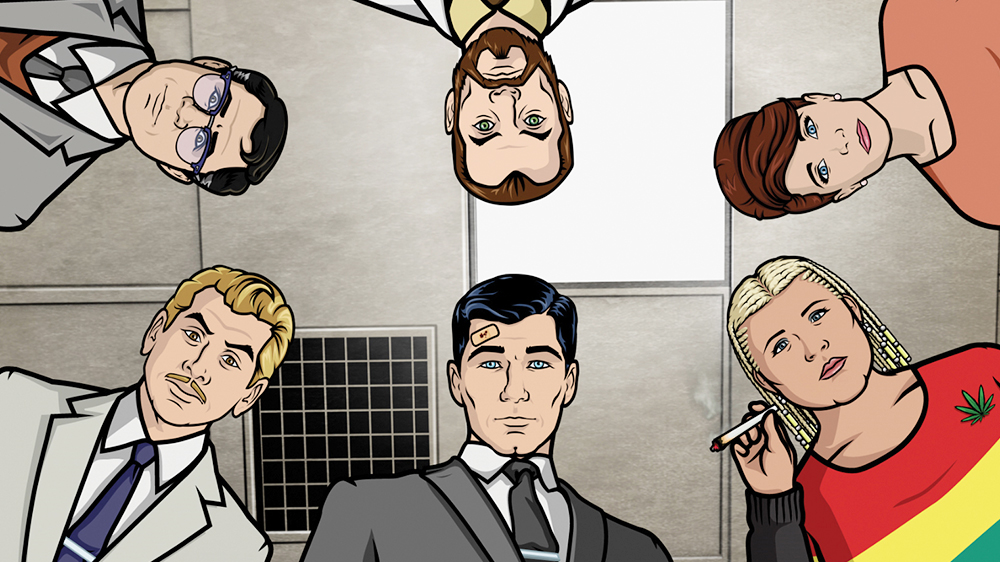How ‘Archer’ Evolved Its Animation Style Over 100 Episodes
By Danielle Turchiano
LOS ANGELES (Variety.com) – When Adam Reed pitched his “James Bond meets ‘Arrested Development’” spy series to FX, he always intended for it to be animated because that was his area of expertise. (Reed’s previous series include “Sealab 2021” and “Frisky Dingo,” both for Adult Swim.)
The cabler, which prides itself on having a slate of successful shows that are “radical deconstructions and reconstructions of genre,” per CEO John Landgraf, did not blink at the idea of adding “Archer,” an adult cartoon, to its lineup in 2009. And as the years have gone by, an increase in animator talent and an evolution of digital technology has allowed the show to take more creative risks.
“When we started it was really just eight of us in this house in East Atlanta,” art director Chad Hurd says. “The house style was limited animation [and] everything was drawn in Adobe Illustrator. We storyboarded everything to be very, very user friendly, but the animation was a little stiffer.”
The first season of “” received a 10-episode order, with the animators at Floyd County Prods. diving right into the season after the pilot was in the can and having to figure out the show’s style as they moved along.
“Archer lived in a very stylish world, and Adam was very set on wanting this ‘Mad Men’ crisp suits look,” Hurd recalls. “Most of the kids that we were working with were straight out of college, and when I started working on ‘Archer’ had maybe worn a suit once before, so it was learning how a suit should fall and looking at the styles of that time.”
In order to best capture the physicality of their characters, “Archer’s” animation team hired models to stand in tailored suits and shot them from all angles, then used these photos as a reference during production. For the first few seasons, the animators were able to return to these photos, as well as already-produced animatics of characters including Archer, Cyril and Ray, who would “wear the exact same suit, just in different colors,” Hurd says.
But after the fourth season, Reed dramatically changed the show. Where it was once an espionage-of-the-week romp with characters often returning to familiar settings of their apartments or the office, the fifth season took the characters down to Florida for much more serialized storytelling. This would become the new norm, with anthology-style seasons that followed set in worlds such as the noir “Dreamland” and 1930s South Pacific (“Danger Island”).
“Most of the kids we were working with were straight out of college…so it was learning how a suit should fall and looking at the styles of that time.”
Chad Hurd
“We’re doing things completely differently, so they all have their own new designs, and they’re much more elaborate in that they require new drawings — there are no reuses,” Hurd says. “I think creatively it’s opened a lot of doors.”
Evolving technology over the past decade has has aided the show’s growth, as well.
In earlier days, for example, animators used standard-issue Adobe After Effects software to create episodes, “but as the years have gone on we’ve written a lot of scripts for it, and we’ve kind of retrofitted it for our needs so our face rigs or body rigs are easier to set up,” Hurd notes.
Floyd County Prods. has used After Effects and Illustrator from the beginning of the show, but they have also added Toon Boom Harmony in more recent seasons. The goal is to push the boundaries of the visual style but not change it so drastically that it becomes distracting.
“Any time we do fluid action — punching, kicking, fighting — we change our animation style a little bit,” says executive producer Matt Thompson. “Hopefully nobody notices too much, but we change programs. Usually when Archer and Lana are talking to each other, we’re doing that animation in After Effects, but when we’re doing kicking or punching, we switch over to Harmony to make sure it looks a little bit smoother.”
The “Danger Island” ninth season increases the use of 3D animation both in action sequences (an Archer versus a German pilot aerial battle) and in texture work (an episode that sees core characters get stuck in quicksand). The 100th “Archer” episode is the “biggest episode we’ve done,” according to Hurd.
“We always kind of made a budget-friendly, animation-friendly cartoon, but we make art, too,” Hurd says.

